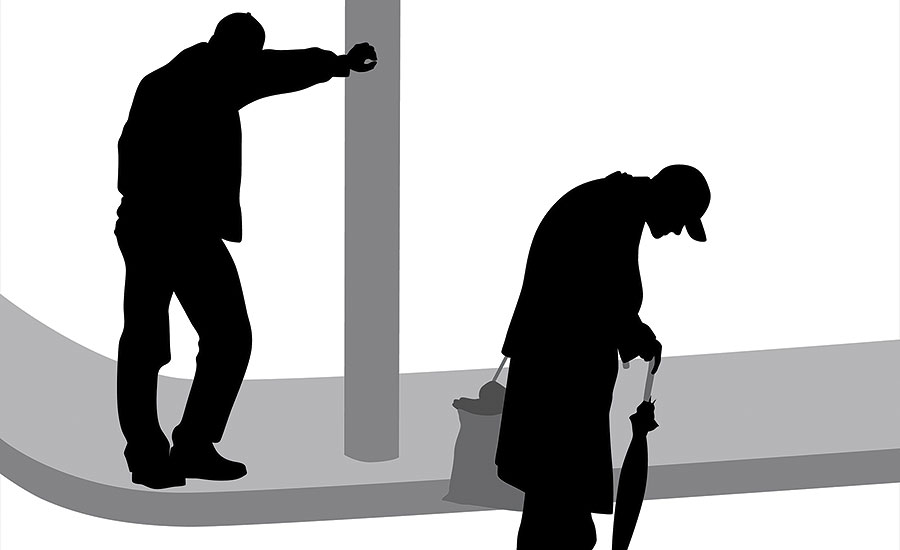Our pressing posture problem
Everyone’s walking around with their heads down

Global mobile devices and connections in 2013 grew to seven billion, up from 6.5 billion in 2012, according to the Cisco Visual Networking index. Smartphones accounted for 77 percent of that growth, with 406 million net additions in 2013. We’re talking millions and millions and billions here.
Not surprisingly, smartphones are popular with environmental health and safety pros. About six out of ten (58 percent) use a smartphone for their work, according to a 2014 ISHN survey. About one in five (22 percent) use some sort of tablet device for work. Laptops (56 percent) and desktops (65 percent) are other typical tools of EHS pros.
Of course business accrues benefits galore from our gilded wired age. Productivity and collaboration climb skyward. And with eighty percent of smartphones used in the workplace owned by employees, just look at the cost savings. Safety and health cashes in on all this technology as well. Workers are less isolated; every employee potentially can shoot a near-miss video; communications, alerts, bulletins, updates are instantly and more broadly disseminated than ever imagined. Accidents can be analyzed and predicted. Behaviors charted. EHS performance metrics sliced and diced.
Putting on the weight
There is one hitch, though. The wired world has a posture problem. We suffer from text neck and back pain. We go around distracted, with our heads down. Look it this way: in a neutral position the human head weighs 10-12 pounds. If you lower your head 15 degrees, you’re almost tripling that weight, according to a physician at New York Spine Surgery and Rehabilitation Medicine. At 30 degrees, it’s 40 pounds. At 45 degrees, it’s nearly 50 pounds and at 60 degrees, it’s 60 pounds.
Now consider that people with smartphones typically spend between two to four hours a day with their heads tilted toward the device. That calculates to between 700 and 1,400 hours a year with additional stress on the spine. And we’re leaving out all the tablet device and laptop users. Ouch.
And all those EHS pros sitting at their desks staring at desktop screens all day long, well, you have to deal with another downside of the modern age – sitting too long. The distress of the sedentary lifestyle. As the author of the new book, “Straight Forward,” says, because there are no muscles behind your spine, your body can’t self-correct, so when you’re sitting, you tilt forward and that causes all the organs in the front of your body to be compressed. Ouch. This in turn leads to problems with digestion, blood pressure and breathing.
In January, 2015, a new review of 47 studies cited increased risk of heart disease, cancer, and Type 2 diabetes as being linked to sitting down too much. The World Health Organization (WHO) claims that physical inactivity is the fourth leading risk factor for global mortality – behind high blood pressure, tobacco use and high blood glucose, causing about 3.2 million deaths a year. And in 2008, WHO claims about 31 percent of adults weren’t active enough.
Who gets intense?
I’m surprised the figure isn’t higher, given that some guidelines call for 30 minutes of high intensity activity every day – even every other day – not raking leaves or gardening or strolling around the block but running, jogging, power-walking, weight training, body bending, sports-playing, or something else that makes you work up a sweat. And then there are all of the obesity stats. According to the Centers for Disease Control and Prevention (CDC), during the past 30 years obesity rates have soared, and now one in three adults is considered obese. Some researchers point to evidence that indicates a correlation between the rise in obesity rates and the introduction of computers into the workplace. A 2011 study from Harvard researchers looking at the period between 1980 and 2008 found mean body mass index worldwide increased dramatically each decade for men and women.
Apparently many employers are slow to catch on to the costs of our slumping posture and soft lives, at work and at home. A poll of U.S. small businesses – which account for 55 percent of all jobs in the country – indicates workplace wellness is not on the radar screens for most of these firms. Getting employees active and moving takes a back seat to, well, just trying to survive, for many little guys. All that government red tape and global competition.
The coming stand-up culture
There are reports that businesses are moving toward something called a standing desk culture. “In five years’ time you’ll see standing desks in offices across cities,” says the author of “Straight Forward.” Of course that’d be great for book sales. And anti-fatigue floor mat sales would skyrocket, too. But I’m not holding my breath.
I do work with words for a living, which means prolonged sitting, keyboard and screen time. So I’ll try to do what mom always said and sit up straight. Docs call it a “neutral spine.” Keep your ears over your shoulders with your shoulders drawn back. I’ll get up every hour and walk around, maybe stuff a towel between my lower back and my chair, maybe do some more sit-ups to strengthen those abs that hold the spine in place. I can’t see sitting on one of those bouncing balance balls all day, or attaching my desk to a treadmill. (You can get a variable height, Bluetooth-enabled model for about $2,000.) And like a lot of people, I should use more of my vacation time to break up all this sitting around. According to one study, two out of every five employees fails to use all of their allotted time off from work each year.
How about you? Ready to get out and about?
Looking for a reprint of this article?
From high-res PDFs to custom plaques, order your copy today!






